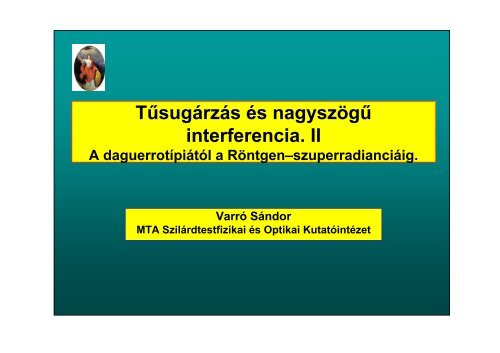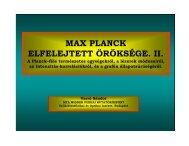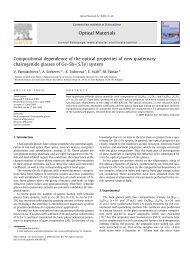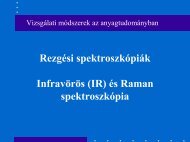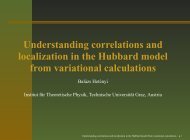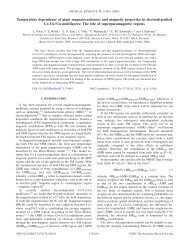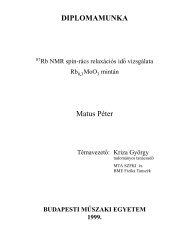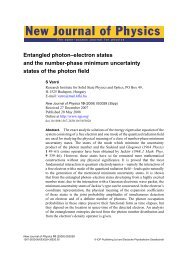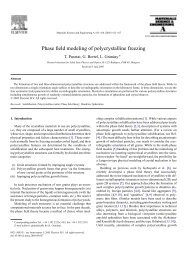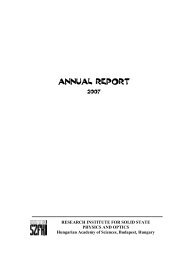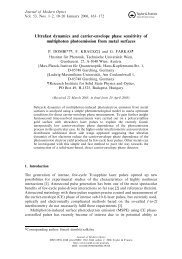prezentáció - MTA SzFKI
prezentáció - MTA SzFKI
prezentáció - MTA SzFKI
Create successful ePaper yourself
Turn your PDF publications into a flip-book with our unique Google optimized e-Paper software.
Tűsugárzás és nagyszögű<br />
interferencia. II<br />
A daguerrotípiától a Röntgen–szuperradianciáig.<br />
Varró Sándor<br />
<strong>MTA</strong> Szilárdtestfizikai és Optikai Kutatóintézet
‘Knowledge is better than ignorance’<br />
E. Fermi
AZ ELSŐ SOLVAY – KONGRESSZUS [ 1911 ]<br />
H. A. Lorentz (Leiden) : Ekvipartíció sugárzásra<br />
W. Nernst (Berlin) : A kvantumelmélet alkalmazása a fajhőre<br />
M. Planck (Berlin) : “Második elmélet”, zérusponti energia, a fásistér<br />
kvantálása<br />
H. Rubens (Berlin) : A Planck-formula kísérleti bizonyítékai<br />
A. Sommerfeld (München) : A hatáskvantum jelentősége nemperiodikus<br />
folyamatokra<br />
W. Wien (Würzburg)<br />
E. Warburg (Charlottenburg) : A Planck-formula kísérleti bizonyítékai<br />
J. H. Jeans (Cambridge) : Kinetikus elmélet, aktív és passzív<br />
szabadsági fokok, fajhő<br />
E. Rutherford (Manchester)<br />
M. Brillouin (Paris)<br />
Madame Curie (Paris)<br />
P. Langevin (Paris) : A mágnesség kinetikus elmélete, “Langevinfüggvény”<br />
J. Perrin (Paris) : A molekulák létezése, Brown-mozgás stb. kísérleti<br />
eredmények<br />
H. Poincaré (Paris)<br />
A. Einstein (Prag) : A fajhő kvantumelmélete, molekulák rotációjának<br />
kvantálása<br />
F. Hasenörl (Wien)<br />
H. Kamerling-Onnes (Leiden) : Elektromos vezetőképesség alacsony<br />
hőmérsékleten<br />
J. D. van der Waals (Amsterdam)<br />
M. Knudsen (Kopenhagen) : Kinetikus elmélet, belső súrlódás,<br />
diffúzió, hővezetés
Vázlat.<br />
■ Rövid ismétlő összefoglalás. Selényi kísérletének<br />
jelentősége a kvantumfizika hőskorában [ J. J.<br />
Thomson, A. Einstein és a „tűsugárzás” ; “needle<br />
radiation” “Nadelstrahlung”, “light darts”,<br />
irányítottság, visszalökődés ].<br />
■ Selényi kísérletének ‘utóélete’; a Röntgen-tartomány<br />
[ Kossel-vonalak, Röntgen-holográfia ]. Röntgen–<br />
szuperradiancia vékony 57 Fe réteggel.<br />
■ Selényi kísérletének ‘utóélete’ az optikában;<br />
monomolekuráris vékonyrétegek fuoreszcenciája.<br />
Zenker – féle rétegek, színes fényképezés.<br />
■ A fázisról és „önkoherenciáról”. Attoszekundum.<br />
[ ■ Lokalizált elektromágneses sugárzási terek; ‘a foton<br />
hullámfüggvényei’. ]
■ Selényi fundamentális kísérletének 100-ik évfordulója [ 1911 – 2011 ]<br />
Paul Selényi, Über Lichtzersteuung im Raume Wienerscher<br />
Interferenzen und neue, diesen reziproke<br />
Interferenzerscheinungen. Annalen der Physik 35, 444 – 460 (1911)<br />
Otto Wiener<br />
Selényi Pál<br />
Selényi Pál-tól : A WIENER-FÉLE ÉS A RECZIPROK INTERFERENCZIA-JELENSÉGEKRŐL. Mathematikai és<br />
Természettudományi Értesítő. 29, 601-640 (1911). (Az M. T. Akadémia III. osztályának 1911 január 16-án tartott üléséből.)<br />
-3 -
“… Ily módon a<br />
‘Mathematikai és<br />
Physikai Társulat’<br />
február 23-i ülésén<br />
egy egyáltalán nem<br />
elsötétített<br />
előadóteremben is<br />
be tudtam mutatni<br />
ezeket az<br />
interferenciajelenségeket.”<br />
1884. November 17. [ Dunaadony ] – 1954. március 21. [ Budapest ]
‘Selényi fringes’ [ inverse Wiener–Lippmann fringes ]. About the Fermi’s method.<br />
Wiener–Lippmann ;<br />
indicator: photoplate;<br />
atom B absorbs<br />
Γ A<br />
>>Γ B<br />
Drude–Nernst;<br />
indicator: through<br />
fluorescence light from B<br />
Selényi; indicator: direct visual observation of light<br />
from fluorescence<br />
Γ A<br />
A. Einstein: fénykvantumok [ 1905, 1909 ] ; hν = A + E kin<br />
, p = hν /<br />
c<br />
On a heuristic point of view about the<br />
creation and conversion of light.<br />
Annalen der Physik 17, 132 (1905)<br />
On the development of our views on the<br />
nature and constitution of radiation.<br />
Physikalische Zeitschrift 10, 817 (1909)<br />
“… by spreading from a point, in<br />
the outgoing light rays the energy<br />
is not distributed continuously to<br />
larger and larger spatial regions,<br />
but these rays consist of a finite<br />
number of energy quanta<br />
localized in spatial points, which<br />
move without falling apart, and<br />
they can be absorbed or created<br />
only as a whole.”<br />
“… the most natural notion seems to me, that<br />
the appearance of the electromagnetic fields of<br />
light would attached to singular points, like in<br />
the case of eletrostatic fields according to the<br />
electron theory. It is not exluded that in such a<br />
theory the energy of the electromagnetic field<br />
could be viewed as localized in these<br />
singularities, like in the old action-at-adistance<br />
theory. I think of such singular points<br />
surrounded by force fields, which, in essence<br />
are of a character of plane waves, whose<br />
amplitudes decrease by the distance from the<br />
singular points. … Needless to say, such a<br />
picture is of no value until it leads to an exact<br />
theory.”<br />
Unfortunately, Einstein has never published either a formula or an illustrative<br />
figure on the mentioned singular electromagnetic radiation fields.
Diffrakció, Kirchhoff-féle integrálegyenlet<br />
[ + Fénykvantumok ? ]<br />
KIRCHHOFF-KÖZELÍTÉS ~<br />
HUYGENS-ELV r ⎡<br />
ik|<br />
x−x′<br />
|<br />
r 1 r ⎛ i ⎞ ⎤<br />
( )<br />
1 ˆ<br />
e<br />
ψ x = − ∫∫ df ′⋅⎢∇′<br />
ψ + ik⎜<br />
+ r r ⎟Rψ<br />
⎥<br />
4<br />
k | x x | | x − x′<br />
|<br />
S S ⎣ ⎝ − ′<br />
r r<br />
π<br />
+<br />
⎠ ⎦<br />
1<br />
2<br />
r<br />
r<br />
S1<br />
S2 →•
“A fényelmélet krízise” [ P. Jordan, 1928 ] II.
Schrödinger [1927] and Compton [1929] on directionality and localization<br />
“The direction and frequency laws of the<br />
Compton effect have exactly the same<br />
meaning as stating that the pair of light<br />
waves and ψ-waves have the same ‘net of<br />
planes’ (on a moving crystal) for the first<br />
order Bragg condition of reflection, as<br />
they move with a subluminar velocity.…”<br />
[ E. Schrödinger, Über den Comptoneffekt. Ann.<br />
Phys. (4) 82, 257-264 (1927) . Fig. 2.]<br />
“There are certain localized<br />
regions in which at a certain<br />
moment energy exists, and this<br />
may be taken as a definition of<br />
what me mean by a particle. …<br />
this wave-mechanics theory does<br />
not enable us to locate a photon or<br />
an electron definitely except at<br />
instant at which it interact with<br />
another particle. When it activates<br />
a grain on a photographic plate,<br />
or ionizes an atom which may be<br />
observed in a cloud chamber, we<br />
can say that the particle was at<br />
that point. But in between such<br />
events the particle cannot be<br />
definitely located.”<br />
[ A. H. Compton, The corpuscular properties<br />
of light. Rev. Mod. Phys. 1, 74-89 (1929) ]
“Sehr gut für Mittelschul’ Experimente.” [ Zworykin, Selényi ‘‘XEROX’ bemutatója’ után ]<br />
Heti két óra fizika
Koherencia, Korreláció II.
WILLIS E. LAMB, Jr., „ANTI – PHOTON” [ 1995 ] II.
Konklúzió Selényi kísérletének korai jelentőségéről<br />
Selényi kísérlete szolgáltatta az első tiszta kísérleti<br />
bizonyítékot az elemi sugárzókból származó<br />
‘gömbfotonok’ nagyszögű önkoherenciájára. Az<br />
eredmény a feltételezett ‘tűsugárzás’<br />
‘irányultságának’ egyik fontos cáfolatát jelentette,<br />
összhangban a modern sugárzáselmélettel.<br />
A Planck-állandó nem a fény sajátja, az emisszió és<br />
abszorpció során fellépő visszalökődés a de<br />
Broglie-Schrödinger hullámok és a klasszikus EM<br />
hullám kvantummechanikai rezonanciájának<br />
(interferenciájának) az eredménye, s pont itt nincs<br />
értelme trajektóriákról beszélni.
Konklúzió. A ‘nem igazi tűsugárzás’ és ‘igazi tűsugárzás’ kérdésében<br />
Sem J. J. Thomson sem A. Einstein nem közölt egyetlen<br />
matematikai formulát, sőt egyetlen részletes képet sem<br />
‘tűsugárról’. Tehát ‘tűsugárelmélet’ valójában nem létezett.<br />
Ugyanakkor, az elképzelés fontos szerepet játszott számos<br />
fontos kísérlet kezdeményezésében.<br />
A lézer, a szinkrotron sugárzás (‘search light’), a Bessel–<br />
nyalábok (azaz ‘nem-diffraktáló nyalábok’), az Oseen-féle<br />
‘Einsteinsche Nadelstichstrahlung’, vagy a mai ‘filament’-ek<br />
egyike sem igazi tűsugár. Ezek egyike sem terjed a<br />
végtelenbe úgy hogy bármilyen távol a forrástól<br />
transzverzálisan koncentrált maradjon.<br />
‘Igazi J. J. Thomson–féle tűsugár’ lehetett volna a Bateman–féle<br />
szinguláris elektromágneses sugárzási vonal, azonban ezt a<br />
fizikusok körében senki sem (ismerte) alkalmazta.<br />
[ Egy lehetséges matematikai modell lehet a ‘meromorf tűsugár’. ]
■ ‘Nadelstrahlung’ concept contradicts Selényi’s experimental results<br />
■ Standing light waves [ H. Hertz, 1888; O. Wiener, 1890; G. Lippmann, 1891;<br />
Nobel prize 1908 for ‘colour photography’]<br />
■ Reciprocal, wide–angle interference [P. Selényi, 1911]<br />
■ Needle radiation [ J. J. Thomson, 1903 ] ‘Nadelstrahlung’<br />
■ Light quanta [A. Einstein, 1905, 1909, 1916 ]: ‘Heuristic viewpoint’ Point–like hν;<br />
photoeffect. Assumption of recoil momentum hν / c in elementary radiation act;<br />
black-body spectrum; thermal equilibrium<br />
■ Recoil, unidirectionality. ‘light darts’: the electromagnetic momentum of a<br />
quantum is in the same direction for all of its energy. G. Breit, P. Jordan [1923]<br />
prove that “unnecessary to assume the unidirectional nature of quanta”<br />
■ G. P. Thomson’s experiments on ‘cutting the light darts’: negative result<br />
A. H. Compton [1923] “Thus even from the quantum viewpoint electromagnetic<br />
radiation is seen to consist of waves.”<br />
■ Assumption of ‘one–sidedness’ of elementary radiation act contradict measured<br />
wide–angle interference [ Pascual Jordan (1928): “Die Krise der Lichttheorie”.<br />
P. Selényi (1911), E.Schrödinger (1920), W. Gerlach & A. Landé (1926) ]<br />
■ W. Kossel [1935] with x-rays discovers analogon of Selényi’s result<br />
■ Needle radiation vs QED [P. A. M. Dirac, P. Jordan, J. C. Slater, 1927]
■ Az elemi sugárzó multipól karakterének kérdése [1937 – 41]<br />
θ<br />
d<br />
= ( di<br />
− d<br />
j<br />
)<br />
max<br />
≤<br />
λ<br />
2nk<br />
cos ε<br />
E = ( S sin θ)<br />
/<br />
R<br />
Electric dipole<br />
■ Theory: F. W. Doermann and O. Halpern, Wide–angle interference of multipole radiation… [<br />
PR 1937, 1938, 1939 ] . ■ Experiment: P. Selényi, Wide–angle interference and the nature of<br />
the elementary light sources. [ PR 1939 ]. ■ Experiment: S. Freed and S. I. Weissmann,<br />
Multipole nature of elementary sources of radiation – wide-angle interference. [ PR 1941 ].<br />
“We confirmed Selényi’s result with a film of fluorescein and examined the fringes at an<br />
angle of divergence 45 o also but noted little change in the visibility. The radiation<br />
emanates, then, from electric dipoles as Selényi had supposed.”
The question of the multipole character of the elementary radiator [ 1939 ]<br />
“A more detailed discussion of this point seems to be justified by the fact<br />
that although in two previous papers the authors had given a very<br />
exhaustive theoretical treatment of wide-angle interferencees, … , they<br />
never recognized or at least never mentioned the experimental difficulties<br />
existing in this respect. As a matter of fact, their treatment is based upon<br />
the assumption that the light source is stricly point-like. Therefore the<br />
influence of the shape and of the finite dimensions of the light source had<br />
not been taken into consideration, though these are the most important<br />
experimental factors which generally prohibit the realization of wide-angle<br />
interferences.”
ÚJ KORSZAK
Neumann János és a Hilbert-tér. 1932.
Neumann János és a Hilbert-tér. 1955a.
Neumann János és a Hilbert-tér. 1955b.
John Bell [ 1964 ]a
Selényi kísérletének utóélete az optikában. A koherencia és fázis problémája.<br />
Selényi kísérletének utóélete az optikában.<br />
Monomolekuláris fluoreszcens rétegek<br />
interferencia-jelenségei. Kapcsolat a (színes)<br />
fényképezéssel, Zenker–rétegek. Kapcsolat a<br />
“betemetett” 57 Fe rétegek Röntgen –<br />
szuperradianciájával.<br />
A ‘fázis-probléma’, vagyis a geometriai struktúrák<br />
rekonstrukciója kvázimonokromatikus esetben<br />
nagyon hasonló mind fényre mind elektronra.<br />
Nagyon különböző viszont széles spektrum<br />
esetében (pl. attoszekundumos impulzusokra).
Monomolekuláris rétegek fluoreszcenciája. Cavity QED. ‘Half-cavity renaissance’<br />
G. A. N.Connel, R. J. Nemanich and C. C. Tsai, Interference enhanced Raman scatterering from very thin absorbing films.<br />
Appl. Phys. Lett. 36, 31-33 (1980)<br />
Ming Lai and J.-C. Diels, Interference between spontaneou emission in different directions. Am. J. Phys. 58, 928-930 (1990)<br />
F. Dubin, et al., Photon Correlation versus Interference of Single-Atom Fluorescence<br />
in a Half-Cavity. PRL 98, 183003 (2007)
Konklúzió. Selényi kísérletének utóélete az optikában, valamint az elemi<br />
sugárzók dipólkatakterével kapcsolatban<br />
A monomolekuláris fluoreszcens rétegekkel észlelt<br />
interferencia-jelenségek megfigyelhetősége végülis<br />
Selényi ‘vékonyréteg–ötletén’ alapul. Az elemi<br />
sugárzók javarésze elektromos dipól (multipól)<br />
karakterű, ezekre érvényes a Helmholtz-féle<br />
reciprocitási tétel. [ Ennek érvényességét pl.<br />
mágneses dipólátmenetre még nem vizsgálták. (?) ]<br />
P , A;<br />
R(<br />
∞,<br />
θ,<br />
φ)<br />
Q′ ; R(<br />
∞,<br />
θ,<br />
φ)<br />
Q<br />
P ′, A′
. ,, [ ]
. ,, [ ]
Konklúzió. Selényi kísérletének utóélete az optikában, valamint az elemi<br />
sugárzók dipólkatakterével kapcsolatban<br />
A monomolekuláris fluoreszcens rétegekkel észlelt interferenciajelenségek<br />
megfigyelhetősége végülis Selényi ‘vékonyréteg–<br />
ötletén’ alapul. Az elemi sugárzók javarésze elektromos dipól<br />
(multipól) karakterű.<br />
Daguerrotípiák. Zenker-rétegek. Színes fényképezés.<br />
Gabriel Lippmann [ 1891, Nobel-díj 1909 ].<br />
Reciprocitás.<br />
P , A;<br />
R(<br />
∞,<br />
θ,<br />
φ)<br />
Q′ ; R(<br />
∞,<br />
θ,<br />
φ)<br />
Q<br />
P ′, A′
■ Primary motivation of the talk; several recent<br />
significance<br />
57<br />
Fe MANIFESTATION OF SELF–<br />
COHERENCE<br />
SOURCE<br />
THROUGH SPATIAL LOCALIZATION OF<br />
■ B. W. Adams, ‘Manipulation of nuclear γ-ray<br />
superradiance.’ Paper 58 at PQE- 2010.<br />
■ R. Röhlsberger, ‘The collective Lamb shift in<br />
nuclear γ-ray superradiance.’ Paper 222 at PQE-<br />
2010 ; See also talk ‘Cooperative emission in the x-<br />
ray regime.’ present PQE- 2011.<br />
■ M. O. Scully et al., ‘Directed spontaneous<br />
emission from an extended ensemble of N atoms :<br />
The timing is everything’. PRL 96, 010501 (2006);<br />
M. O. Scully, ‘Collective Lamb shift in single<br />
photon superradiance.’ PRL 102, 143601 (2009)<br />
d<br />
= ( di<br />
− d<br />
j<br />
)<br />
max<br />
≤<br />
λ<br />
2nk<br />
cos ε
Nagyszögű interferencia Röntgen –sugarakkal. A‘fázis –probléma ’[1984–5]<br />
( a ) ~ Selényi: reciprok interferencia. ( b ) ~ Wiener: álló fényhullámok.<br />
FIG. 1. (a) Schematic diagram of Kossel-line production due<br />
to x-ray emission by an atom on the surface of a crystal. The<br />
interference between the Bragg-reflected wave and that<br />
directly emitted into the same direction allows the phase of the<br />
structure factor to be determined.<br />
(b) Schematic diagram of interferometry technique. An<br />
absorbing atom on the crystal surface samples the standing<br />
wave created by Bragg-reflection, allowing the phase to be<br />
determined. Note that, by the reciprocity theorem, this<br />
experiment is equivalent to the Kossel-line technique, (a).
A ‘ fázis – probléma ’. Blaschke phase. Paley – Wiener condition.<br />
[ Abklingszeit. Verweilzeit. Kvantum Zénon effektus ]<br />
γ<br />
ϕ<br />
∞<br />
∫<br />
0<br />
() ( )<br />
−iωτ<br />
τ = dωg<br />
ω e<br />
γ<br />
( τ) = | γ( τ) | exp[ ϕ( τ)<br />
]<br />
ϕ( τ)<br />
= ϕM<br />
( τ)<br />
+ ϕB<br />
∞<br />
2 ln| γ( τ′ ) |<br />
() τ = τP∫<br />
dτ′<br />
2 2<br />
π τ′ −τ<br />
() ∑ ⎛ τ−τ<br />
M ⎟ ⎞<br />
n<br />
ϕ<br />
⎜<br />
B<br />
τ = arg<br />
∗<br />
τ−τ<br />
0<br />
n<br />
n ⎠<br />
‘ Michelson – fázis’<br />
‘ Blaschke – fázis’<br />
⎝<br />
( τ)
Incoming electric field strength and 10 locked high-harmomics<br />
1<br />
D u r a t i o n = 3 0 T<br />
Electric<br />
Fiel<br />
d Strengt h<br />
0 . 5<br />
0<br />
- 0 . 5<br />
- 1<br />
0 5 1 0 1 5 n21<br />
0 2 5 3 0<br />
2<br />
2<br />
tim e in U n its T iφn<br />
−inω⋅t<br />
E ( t)<br />
= 2 S<br />
N<br />
( t)<br />
, where S<br />
N<br />
( t)<br />
≡ ∑ Ene<br />
e , N ≡ n1<br />
D u r a t i o n = 8 Tn<br />
= n<br />
0<br />
−<br />
n<br />
0<br />
Locked<br />
Harmoni<br />
cIntensit<br />
y<br />
1<br />
0 . 8<br />
0 . 6<br />
0 . 4<br />
0 . 2<br />
1 2 1 3 1 4 1 5 1 6 1 7 1 8<br />
tim e in U n its T<br />
Varro_ECLIM_2010
Is the HHG radiation a quantummechanical product state<br />
of coherent components with ω’=n ω ?<br />
Log<br />
of<br />
Signa l<br />
1<br />
0.8<br />
0.6<br />
0.4<br />
E<br />
N<br />
( t)<br />
=<br />
n=<br />
n0<br />
+ N<br />
∑<br />
n=<br />
n<br />
0<br />
E<br />
n<br />
e<br />
−inωt<br />
=<br />
Φ<br />
f<br />
Eˆ<br />
Φ<br />
f<br />
0.2<br />
0<br />
0 5 10 15 20<br />
Number of Absorbed Photons<br />
Φ<br />
f<br />
= α<br />
n ω<br />
α<br />
n + 1) ω<br />
⋅⋅⋅<br />
α<br />
( n + ) ω<br />
0 ( 0<br />
0 N<br />
T<br />
fi<br />
t<br />
ie<br />
= ∫ dt′<br />
ψ<br />
f<br />
xˆ ( t′<br />
) ψ<br />
i<br />
⋅ Φ ˆ<br />
f<br />
E(<br />
r,<br />
t′<br />
)<br />
h<br />
0<br />
Φ<br />
i<br />
t e t t<br />
0<br />
d(<br />
) = − ψ ( ) xˆ<br />
ψ ( ) = ∑ d<br />
Φ<br />
f<br />
n<br />
ˆ ( , ) ~ 1 ˆ +<br />
E r t ′ Φ A 0 =<br />
Varro_ECLIM_2010<br />
e −inω<br />
t<br />
n<br />
i<br />
ω′ ω′<br />
1
z = e z z =| z |<br />
e<br />
iϕ ∗ iϕ<br />
+ iΦ 2<br />
A<br />
=<br />
E<br />
A<br />
A<br />
=<br />
eˆ N 1/<br />
C<br />
≡<br />
( eˆ<br />
i Φ +<br />
eˆ<br />
−iΦ<br />
)<br />
/<br />
2<br />
ΔC<br />
2<br />
≡<br />
( C − C )<br />
2<br />
S<br />
≡<br />
( eˆ<br />
i Φ −<br />
eˆ<br />
−iΦ<br />
)<br />
/<br />
2i<br />
ΔS<br />
2<br />
≡<br />
( S − S )<br />
2<br />
S. V., Entangled photon-electron states and the number-phase minimun-uncertainty states of the photon<br />
field. New Journal of Physics 10, 053028 (2011); S. V., Entangled states and entropy remnants of a<br />
photon-electron system. Physica Scripta T140, 014038 (2010)
A SUGÁRZÁS KVANTUM-FÁZISA<br />
z = e z z =| z |<br />
e<br />
iϕ ∗<br />
iϕ<br />
A<br />
=<br />
E<br />
A<br />
+<br />
A<br />
=<br />
eˆ<br />
iΦ<br />
N<br />
1/ 2<br />
Φ ˆ =<br />
ϕ + 2π<br />
0<br />
∫<br />
ϕ<br />
ψdEˆ<br />
0<br />
ψ
g<br />
(1,1)<br />
M<br />
( x<br />
1<br />
; x<br />
2<br />
)<br />
≡<br />
[ G<br />
(1,1)<br />
( x<br />
1<br />
G<br />
; x<br />
(1,1)<br />
1<br />
( x<br />
) ⋅ G<br />
; x )<br />
( x<br />
1 2<br />
(1,1)<br />
2<br />
; x<br />
2<br />
)]<br />
1/ 2<br />
I<br />
max<br />
− I<br />
min<br />
(1,1)<br />
l ≡<br />
= l ( x)<br />
= g ( x1,<br />
x<br />
2<br />
)<br />
I + I<br />
ξ ⋅ η<br />
ξ ⋅ η<br />
max<br />
−1<br />
=<br />
∫ ∫∫∫<br />
min<br />
F<br />
1<br />
= 1 ± = 1 ±<br />
M<br />
(1,1)<br />
2<br />
S<br />
( x1)<br />
FT<br />
( t1)<br />
FS<br />
( x<br />
2<br />
) FT<br />
( t2<br />
) | G12<br />
( x1,<br />
t1;<br />
x<br />
2<br />
, t2<br />
) | dx1dt1dx<br />
2dt<br />
2<br />
M<br />
x<br />
1<br />
M M<br />
y<br />
l<br />
or<br />
t<br />
NormalizedCoincidenceRate<br />
2.0<br />
1.5<br />
1.0<br />
0.5<br />
0.0<br />
-1.5 -1.0 -0.5 0.0 0.5 1.0 1.5<br />
» x - x 0 » @au D<br />
Attosecond<br />
pulse as<br />
quantum<br />
mechanical<br />
phase state;<br />
contrast<br />
+ 4 / 3<br />
S. V., Attosecond shot noise. Physics of Quant. Electronics, PQE-41 (2011), ECLIM-31 (2010)<br />
Varro_ECLIM_2010
Some possible arrangements for correlation measurements<br />
Arrangement 1 Arrangement 2<br />
Arrangement 2 Arrangement 3<br />
S. V., N. Kroó, A. Nagy, D. Oszetzky, A. Czitrovszky, HBT type correlations with<br />
surface plasmons. Physics of Quant. Electronics, PQE-41 (2011), JMO (2011)
1) Opposite output, 2) Photon anti-correlation is expected<br />
Possible trigger configurations; reflected or twin photon<br />
Corr<br />
Corr
HANBURY BROWN AND TWISS – TYPE<br />
CORRELATIONS WITH X-RAY PHOTONS<br />
P<br />
AB<br />
η<br />
Aη<br />
( hω)<br />
= ∫ ∫∫∫<br />
B<br />
(2)<br />
F<br />
2 S<br />
( x1)<br />
FT<br />
( t1)<br />
FS<br />
( x<br />
2<br />
) FT<br />
( t2<br />
) Γ12<br />
( x1,<br />
t1;<br />
x<br />
2<br />
, t2<br />
)<br />
P<br />
AB<br />
P<br />
P<br />
⎡<br />
⎢1<br />
+<br />
⎢⎣<br />
1<br />
Varro_CEWQO2010<br />
dx<br />
1<br />
dt<br />
⎤<br />
⎡<br />
⎥ = ξ ⋅ η = ξ ⋅ η ⎢1<br />
+<br />
⎥⎦<br />
⎢⎣<br />
M<br />
1<br />
dx<br />
=<br />
A B<br />
M<br />
xM<br />
yM<br />
t<br />
xM<br />
yM<br />
t<br />
1<br />
2<br />
dt<br />
2<br />
⎤<br />
⎥<br />
⎥⎦
“All the performed experiments belong to the regime of self-interference because the phase-space density of any<br />
neutron beam is extremely low (10 -14 ) and nearly every case when a neutron passes through the interferometer the<br />
next neutron is still in a uranium nucleus of the reactor fuel.” [ H. Rauch, J. Sumhammer, M. Zawisky and E. Jericha:<br />
Low-contrast and low-counting-rate measurements in neutron interferometry. Phys. Rev. A 42, 3726-3732 (1990) ]<br />
2<br />
M x<br />
M y<br />
= (1/ λ ) AΩ<br />
Detector B; vary M l<br />
Source aperture S<br />
Beam splitter BS<br />
Detector A<br />
Mosaic<br />
ξ ⋅ η<br />
ξ ⋅ η<br />
= 1 −<br />
M<br />
x<br />
1<br />
M<br />
y<br />
M<br />
l<br />
Image of source<br />
Varro_CEWQO2010
NEUTRON HULLÁMOK INTENZITÁS-INTENZITÁS KORRELÁCIÓJA;<br />
EGYRÉSZECSKÉS ÖNINTERFERENCIA EFFEKTUS<br />
1<br />
NormalizedCorrelation<br />
ξ ⋅ η<br />
ξ ⋅ η<br />
1<br />
= 1 − = 1 −<br />
M<br />
M<br />
x<br />
1<br />
M<br />
y<br />
M<br />
t<br />
0.9<br />
0<br />
x - x 0<br />
S. V., The role of self–coherence in correlations of bosons and fermions. Fortschr. Phys.59,296-324(2011)<br />
Varro_CEWQO2010
Needle radiation, wide-angle interference and ‘quantum nano-optics’.<br />
The 100 years old experiment on wide-angle interference by Pál Selényi;<br />
a Hungarian scholar at the cradle of the modern concept of photons<br />
[ S. V., EURONANO – 2011 ]<br />
ARTIFICIAL NANO – LAYERS [ of thickness < wavelength / 20 ~ 25 nm ].<br />
Self-interference<br />
Excitation<br />
Total reflection<br />
RADIATORS IN NATURAL THIN PLANES.<br />
( a ) ~ Wiener’s standing waves. ( b ) ~ Selényi’s reciprocal interference.
Megjegyzés. A ‘nem igazi tűsugárzás’ és ‘igazi tűsugárzás’ kérdésében<br />
Sem J. J. Thomson sem A. Einstein nem közölt egyetlen<br />
matematikai formulát, sőt egyetlen részletes képet sem<br />
‘tűsugárról’. Tehát ‘tűsugárelmélet’ valójában nem létezett.<br />
Ugyanakkor, az elképzelés fontos szerepet játszott számos<br />
fontos kísérlet kezdeményezésében.<br />
A lézer, a szinkrotron sugárzás (‘search light’), a Bessel–<br />
nyalábok (azaz ‘nem-diffraktáló nyalábok’), az Oseen-féle<br />
‘Einsteinsche Nadelstichstrahlung’, vagy a mai ‘filament’-ek<br />
egyike sem igazi tűsugár. Ezek egyike sem terjed a<br />
végtelenbe úgy hogy bármilyen távol a forrástól<br />
transzverzálisan koncentrált maradjon.<br />
‘Igazi J. J. Thomson–féle tűsugár’ lehetett volna a Bateman–féle<br />
szinguláris elektromágneses sugárzási vonal, azonban ezt a<br />
fizikusok körében senki sem (ismerte) alkalmazta.
C. W. Oseen [ 1922 ] ““Einstein-féle tűsugárzás”” [ “Nadelstichstrahlung” ] I.<br />
“As for a concrete example to mention, in this way one can find a solution of<br />
the Maxwell equations which represents a radiation from a point-like source<br />
on the Earth, whose all energy up to 1/10 10 goes out to infinity within a solid<br />
angle, which would cut a surface of size of a 5 penny coin on the surface of<br />
the Sirius.” [ C. W. Oseen, Ann. der Phys. (4) 69, 202-204 (1922) ]<br />
2<br />
B = ∇×∂Π<br />
/ c∂t E = ∇×∇×Π<br />
Π =( 0,0, P)<br />
∂ P= 0<br />
P<br />
⎡<br />
⎢a<br />
⎢⎣<br />
=<br />
0 1<br />
⎛ic<br />
∂<br />
+ a ⎜<br />
⎝ ω ∂z<br />
⎞<br />
⎟+<br />
⎠<br />
... + a<br />
n<br />
n<br />
⎛ic<br />
∂ ⎞<br />
⎜ ⎟<br />
⎝ ω ∂z<br />
⎠<br />
⎤ e<br />
⎥<br />
⎥⎦<br />
iω(t<br />
−r / c )<br />
r
C. W. Oseen [ 1922 ] ““Einsteinian” needle radiation”” [ “Nadelstichstrahlung” ]<br />
II.<br />
E<br />
x<br />
ω<br />
→−<br />
c<br />
2<br />
2<br />
xz<br />
F(<br />
z/<br />
r)<br />
e<br />
3<br />
r<br />
iω(<br />
t−r/<br />
c)<br />
F z/<br />
r)<br />
= a + a ( z/<br />
r)<br />
+ ... a ( z/<br />
r)<br />
(<br />
0 1<br />
+<br />
n<br />
n<br />
c<br />
S = E×<br />
B 4 π<br />
S ~ [ F(<br />
z/<br />
r)]<br />
Let f ( z / r ) be a continuous function on the interval [ –1 , +1 ]. Then,<br />
according to the approximation theorem of Weierstrass, for any (small)<br />
positive ε one can find an n-th degree polynomial with real coefficients<br />
a 1 , a 2 , …, a n , such that this (arbitrarily) approximates the function f,<br />
2<br />
Now let us choose f ( z / r ) such that<br />
f ( z/<br />
r)<br />
= 0, −1≤<br />
( z/<br />
r)<br />
≤cosϑ<br />
| F(<br />
z/<br />
r)<br />
− f ( z/<br />
r)|<br />
The photon wave function of L. D. Landau and R. Peierls [ 1930 ]<br />
and I. Bialynicki-Birula [ 1989 ].<br />
F<br />
3<br />
( r,<br />
t ) = ∫ d kk<br />
× [ ikh(<br />
k)<br />
− k h(<br />
k)]<br />
e<br />
+<br />
×<br />
−iωt+<br />
ik⋅r<br />
L. D. Landau and R. Peierls, Quantum<br />
electrodynamics in konfiguration space.<br />
Z. Physik 62, 188-191 (1930)<br />
I. Bialynicki-Birula, Exponential<br />
localization of photons. PRL 80, 5247-<br />
5250 (1998)<br />
h(<br />
k)<br />
=<br />
m<br />
l −3<br />
−kl−1<br />
/ kl<br />
k<br />
hc<br />
e<br />
ψ<br />
h(<br />
k)<br />
= m<br />
p ′ γμψ<br />
p<br />
A<br />
μ<br />
+<br />
lk<br />
−5/<br />
2<br />
e<br />
−kl−1/<br />
kl<br />
Notice the diffetent negative exponents –3 and –5/2. The physical significance of these mathematical<br />
constructions is not clear, though I. B-B. interrelates his wave function with localized photodetection.<br />
Clearly the parameter ‘r’ should then be the position of the nucleus of the atom, from which the electron<br />
has been delibarated. After all, the electrons are detected in the counters, and not directly the position of<br />
the nucleus. Now, let us consider a Compton scattering on this field configuration with the interaction<br />
term shown above. The matrix element contains an ESSENTIAL SINGULARITY of type<br />
exp[ a / |p’-(p+k)| ]. According to H. J. Bhabha [ Phys. Rev. 70, 759 (1946) ], in general, essential<br />
singularities correspond to non-physical formulae. In our present example the essential singularity is at<br />
the the usual momentum conservation point. A theorem of the theory of functions says that if a function<br />
has an essential singularity, then in an arbitrary neigbourhood of this singularity the function takes<br />
infinitely many times infinitely many different values.
Egy lehetséges ‘meromorf tűsugár család’ [ V. S., 2011 ] I.<br />
( ∂<br />
2<br />
/ c<br />
2<br />
∂t<br />
2<br />
− ∇<br />
2<br />
) A<br />
μ<br />
=<br />
0<br />
1. Vákuumbeli hullámegyenlet<br />
B<br />
z<br />
= ∂<br />
x<br />
Ay<br />
− ∂<br />
y<br />
Ax<br />
= 0<br />
∂<br />
x<br />
A<br />
x<br />
+ ∂<br />
y<br />
A<br />
y<br />
= 0<br />
2. Cauchy – Riemann<br />
egyenletek<br />
Ay + iAx<br />
= f ( t ± z / c)<br />
w(<br />
x + iy)<br />
3. ‘w’ meromorf függvény az x+iy<br />
komplex síkon, és ‘f ’tetszőleges.<br />
Igy például konstruálni lehet monokromatikus elektromágneses sugárzási<br />
téreloszlásokat, amelyeknek másodrendű pólusai vannak. Az alábbi tér az N pólus<br />
helyétől eltekintve holomorf, és kielégíti az eredeti Maxwell-egyenleteket. Még<br />
érdekesebb, hogy egy ilyen típusú térrel vett kölcsönhatás esetében a Klein-Gordon<br />
és Dirac-egyenlet néhány elég jól kezelhető egzakt megoldásokkal is rendelkezik.<br />
A<br />
y<br />
+ iA<br />
x<br />
= ( cF<br />
0<br />
/ ω<br />
0<br />
)cos[ ω<br />
0<br />
( t<br />
±<br />
z<br />
/ c)]<br />
×<br />
a<br />
N<br />
k<br />
∑<br />
k = 1 ( z − zk<br />
)<br />
2
Egy lehetséges ‘meromorf tűsugár család’ [ V. S., 2011 ] II.<br />
Out[2]=
‘Electron needle radiation’ in ionization of a Rydberg atom. SU(1, 1) dynamics.<br />
⎡<br />
⎢<br />
−<br />
⎣<br />
x<br />
1<br />
2<br />
1<br />
Δ −<br />
r<br />
−i<br />
∂<br />
∂z<br />
( e<br />
/ ω)(a<br />
+ a<br />
= z<br />
ψ( u )<br />
0<br />
) + ω( a<br />
2 2<br />
2λμcosϕ,<br />
y = 2λμsin<br />
ϕ,<br />
= λ − μ<br />
u<br />
⎡<br />
= exp⎢<br />
⎣<br />
Eccentric anomaly; u<br />
ε u<br />
ω<br />
+<br />
+<br />
⎤<br />
a − N )<br />
⎥<br />
⎦<br />
Ψ<br />
=<br />
E<br />
Squared parabolic<br />
coordinates<br />
Ψ<br />
(<br />
iθ<br />
−iθ<br />
e ( K − L ) − e ( K − L )) ( 0 )<br />
0<br />
+ +<br />
− −<br />
ψ<br />
2 0<br />
Particle<br />
⎤<br />
⎥<br />
⎦<br />
4<br />
ε0 ≡ n0<br />
F0<br />
, ω0<br />
≡ n<br />
3<br />
0<br />
ω<br />
f<br />
( λ,<br />
μ ) →<br />
f<br />
( λe<br />
, μe<br />
γu −γu<br />
)<br />
S. V., Streching and squeezing of a highly-excited H-atom at the main resonance. [ Unpublished ]
A Maxwell-egyenletek. Az éter létezésének kérdése. I.<br />
MAXWELL FARADAY<br />
THOMSON<br />
“The difficulty of imagining a definite uniform limit of divisibility of matter will<br />
always be a philosophical obstacle to an atomic theory, so long as atoms are regarded<br />
discrete particles moving in empty space. But as soon as we take the next step in<br />
physical development, that of ceasing to regard space as mere empty geometrical<br />
continuity, the atomic constitution of matter ( each ultimate atom consisting of<br />
parts which are incapable of separate existence, as Lucretius held ) is raised to a<br />
natural and necessary consequence of the new stanpoint. We may even reverse the<br />
argument, and derive from the ascertained atomic constitution of matter a<br />
philosophical necessity for the assumption of a plenum, in which the ultimate atoms<br />
exist as the nuclei which determine its strains and motions.”<br />
[ Larmor : Aether and Matter. (1900) ]
A Maxwell-egyenletek. Az éter létezésének kérdése. II.<br />
“… Wenn man die Quantentheorie als (im Prinzip) endgültig ansehen will, so muß man<br />
glauben, daß eine vollständigere Beschreibung zwecklos wäre, weil es für sie keine<br />
Gesetze gäbe. Wenn es so wäre, dann würde die Physik nur mehr für Krämer und<br />
Ingenieure Interesse beanspruchen können; das ganze wäre ein trauriges<br />
Pfuschwerk.<br />
Du betonst nun ganz richtig, daß die vollständige Beschreibung nicht auf den Begriff<br />
der Beschleunigung aufgebaut werden kann und – wie mir scheint – ebesowenig<br />
auf den Teilchenbegriff. Es bleibt also von unserem Handwerkzeug nur der<br />
Feldbegriff übrig; aber der Teufel weiß, ob dieser standhalten wird. Ich denke, es<br />
lohnt sich, an diesem, d. h. am Kontinuum festzuhalten, solang wenn man keine<br />
wirklich stichhältigen Gründe dagegen hat….”<br />
“…Ha az ember a kvantumelméletet (elvben) véglegesnek akarja tekinteni, akkor azt<br />
kell hogy higgye, hogy egy teljesebb leírás céltalan lenne, mivel ehhez nem<br />
lennének törvények. Ha ez így lenne, akkor a fizika többé már csak a szatócsok és<br />
mérnökök érdeklődésére tarthatna számot; az egész egy szomorú kontármunka<br />
lenne.<br />
Egészen helyesen fejezed ki, hogy a teljes leírás nem építhető fel a gyorsulás<br />
fogalmára, és – ahogy nekem tűnik – éppoly kevéssé a részecskefogalomra.<br />
Munkaeszközeink közül tehát csak a térfogalom marad; de az ördög tudja, hogy ez<br />
kitart-e. Úgy gondolom, hogy megéri ehhez, vagyis kontinuumhoz ragaszkodni,<br />
mindaddig amíg nincsenek valóban elfogadható érvek ellene….”<br />
[ Einstein an Schrödinger, Dezember 22. 1950. in K. Przibram (Ed.), Briefe zur Wellenmechanik. 18. (Wien, Springer-Verlag, 1963 ) ]
“As a matter of fact, their treatment is based upon the<br />
assumption that the light source is stricly point-like. Therefore<br />
the influence of the shape and of the finite dimensions of the<br />
light source had not been taken into consideration, though these<br />
are the most important experimental factors which generally<br />
prohibit the realization of wide-angle interferences.”<br />
[ P. Selényi, Wide-Angle Interference and the Nature of the Elementary<br />
Light Sources. Phys. Rev. 56, 486-488 (1939) ]<br />
“Munkásságára jellemző, hogy egyszerű<br />
eszközökkel dolgozta ki jelentős és<br />
időtálló eredményeit, melyek új<br />
gondolatok ébresztésére hivatottak.”<br />
[ SELÉNYI PÁL ÖSSZEGYŰJTÖTT MUNKÁI ( Akadémia Kiadó, Budapest, 1969 )<br />
Sajtó alá rendezte Bodó Zalán. Részlet a kiadó előszavából. ]


